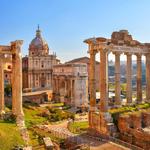Ashley & AugustoCarlo
Things To Do
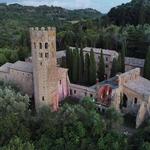
La Badia di Orvieto
The Isle of Stone in a Sea of Green. The wedding will be held at La Badia (the Abbey) di Orvieto. La Badia’s church and sacristy was built in the 6th century to pay homage to Saint Severus. Legend says that a noble woman, Lady Rotruda, came to pay her respects to his grave and her hand became stuck when she placed it on his tomb. It wasn't released until she promised to fund an Abbey to pay tribute to his remains. The twelve sided tower was added in 1103. In 1464, La Badia was the home of Pope Paul II. La Badia is equipped with air conditioning, tvs, a swimming pool and tennis courts.
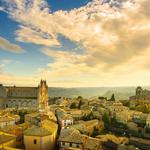
Orvieto
Tour the town! Orvieto is true Italian hill town located less than two miles from La Badia. Orvieto was first inhabited by the Etruscans in the 3rd century BC. The current city is built on Tufa rock that is believed to have been formed when a volcano located in present day Lake Bolsena erupted. It is located in the Province of Terni, in southwest Umbria. The city is sprinkled with little shops full of handmade pottery, jewelry, clothing and artwork...just to name a few. Orvieto is also the favorite city of the Groom.
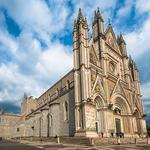
Duomo di Orvieto
Duomo di Orvieto is a large 14th-century Roman Catholic cathedral dedicated to the Assumption of the Virgin Mary. It is situated in the middle of the town of Orvieto. It was started in 1290 and completed in 1591. In September the visiting hours will be from 9:30am- 7pm (19:00).
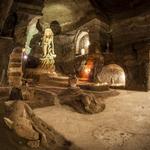
Orvieto Underground
The city built on a city. The current city of Orvieto was built on top of a maze of tunnels carved by the Etruscans. Some of the tunnels are over 2500 years old. Among these tunnels are Hadrian's Labyrinth, which is a place where visitors can admire a vivid example of an underground city. This is not recommended for people who have a hard time walking or who have a fear of small spaces.

Well of St. Patrick
The Pozzo di San Patrizio (St. Patrick's Well) is a historic well in Orvieto. It was built by the architect-engineer Antonio da Sangallo of Florence, between 1527 and 1537, at the request of Pope Clement VII who had taken refuge in Orvieto during the sack of Rome in 1527. There are 248 steps and 70 windows which provide illumination.
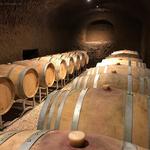
Madonna del Latte
The ancient estate of Madonna del Latte is located in the hills between Orvieto and Lake Bolsena. Today it is a small family-owned winery founded in 2000. The vines flourish on the slopes of rich, sandy volcanic soil at an altitude of 450 meters. Depending on which tasting you select, you will be greeted with a variety of wines, cheeses and meat pairings indicative of Orvieto. You will also be able to visit the wine cellars that were carved by the Etruscans 2500 years ago. P.S. if you look closely at the walls, you are still able to see the chisel marks made thousands of years ago.

Sacro Bosco
The Sacro Bosco, also known as the Park of the Monsters for the presence of grotesque sculptures scattered in a surreal landscape, is the oldest sculpture park in the modern world. Some of the sculptures date back to 1552. The park is located 24 miles, approximately 33 minutes, from the town.
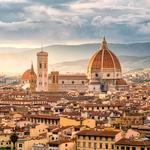
Florence
Florence, the birthplace of the renaissance, is located approximately two hours (102.8 miles) northwest of Orvieto by train. It is home to one of the most recognizable cathedrals in the world, the Cathedral of Santa Maria del Fiore, as well as the Ponte Vecchio (Italy's gold bridge) and houses some of the worlds most famous works of art such as Michelangelo's David, Botticelli's the Birth of Venus and Primavera. Florence is also the final resting place of Machiavelli, Michelangelo, Galileo and Dante in the beautiful cathedral of Santa Croce. Florence is also the favorite city of the bride.
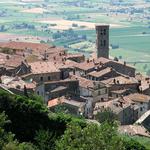
Cortona
Cortona is located 57 miles away from Orvieto, just over an hour on the train. It is the home of the Imperial villa of Ossaia. This is also the backdrop of the movie "Under the Tuscan Sun".
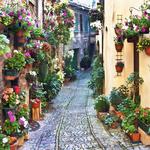
Spello
Spello is located 61 miles away, which is an hour and half car ride or two hour train ride. It is famous for being voted one of the most beautiful cites in Italy, and for having the most flowers to line the streets.

Civita di Bagnoregio
Civita di Bagnoregio is mere 15 miles, only 34 minutes away from Orvieto. It’s accessed via a pedestrian bridge from the nearby ticket office in Bagnoregio village. The Porta Santa Maria gateway was built by the Etruscans. Although there are no major sights in this town the scenic views are said to be outstanding.

Perugia
This picturesque Umbrian city has a history that spans many eras. The city wall and arch are Etruscan; the sixth-century Sant'Angelo church was built atop a Roman temple; the town's cathedral is both Gothic and Renaissance. If you have a sweet tooth, visit the famous Perugina chocolate factory; if you have a full set of sweet teeth, visit during the Eurochocolate festival, held in October, when the entire town reportedly smells of chocolate. Perugia is 49 miles about an hour and a half from Orvieto.
